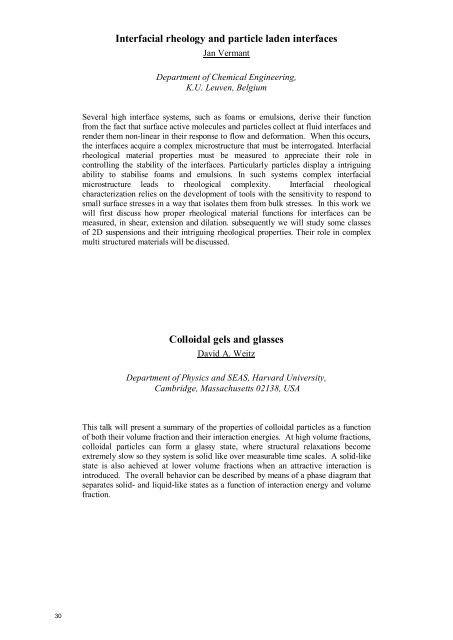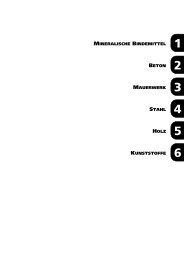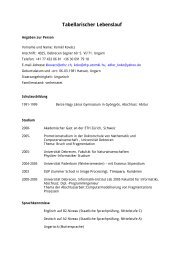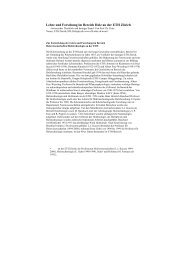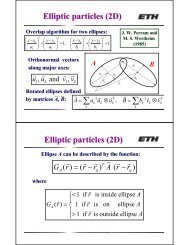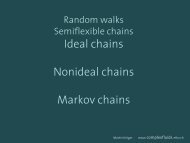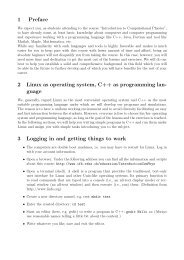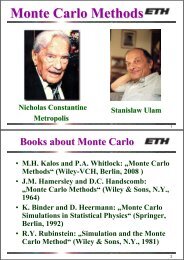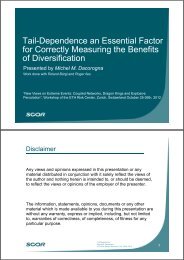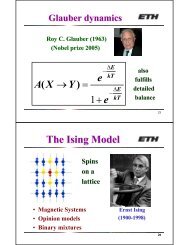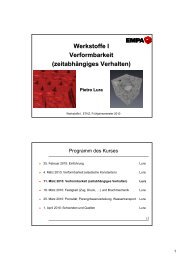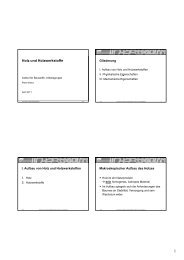Interfacial rheology and particle laden interfacesJan VermantDepartment of Chemical Engineering,K.U. Leuven, BelgiumSeveral high interface systems, such as foams or emulsions, derive their functionfrom the fact that surface active molecules and particles collect at fluid interfaces andrender them non-linear in their response to flow and de<strong>for</strong>mation. When this occurs,the interfaces acquire a complex microstructure that must be interrogated. Interfacialrheological material properties must be measured to appreciate their role incontrolling the stability of the interfaces. Particularly particles display a intriguingability to stabilise foams and emulsions. In such systems complex interfacialmicrostructure leads to rheological complexity. Interfacial rheologicalcharacterization relies on the development of tools with the sensitivity to respond tosmall surface stresses in a way that isolates them from bulk stresses. In this work wewill first discuss how proper rheological material functions <strong>for</strong> interfaces can bemeasured, in shear, extension and dilation. subsequently we will study some classesof 2D suspensions and their intriguing rheological properties. Their role in complexmulti structured materials will be discussed.Colloidal gels and glassesDavid A. WeitzDepartment of Physics and SEAS, Harvard University,Cambridge, Massachusetts 02138, USAThis talk will present a summary of the properties of colloidal particles as a functionof both their volume fraction and their interaction energies. At high volume fractions,colloidal particles can <strong>for</strong>m a glassy state, where structural relaxations becomeextremely slow so they system is solid like over measurable time scales. A solid-likestate is also achieved at lower volume fractions when an attractive interaction isintroduced. The overall behavior can be described by means of a phase diagram thatseparates solid- and liquid-like states as a function of interaction energy and volumefraction.30
Required Subjects <strong>for</strong> the Study of Concrete RheologyK.Yamada 1 , Y.Yamada 21 Taiheiyo Consultant, Chiba, Japan (Taiheiyo Cement Group). 2 University of the Ryukyus.INTRODUCTION: The goal of fluidity study isthe estimation of concrete workability, e.g.comprehensive properties such as easiness ofhandling at various w/c, passability and blockingbehaviors between high-density rein<strong>for</strong>cementsrequired from seismic rein<strong>for</strong>cement, segregationsto <strong>for</strong>m rock pockets and breeding and so on.However, because of the lack of overall vision ofstudies, there has been limitations. For example,simple paste flow or flow curve tests under specificconditions were index <strong>for</strong> the study of workingmechanism of superplasticizers (SP). Despite ofthe existence of their stress history dependence, ithas been difficult to carry out time consumingmeasurements <strong>for</strong> the study discussing hugenumber of material character’s effects. This is abig frustration not to be able to consider shear rateand time dependence of de<strong>for</strong>mation. <strong>Here</strong>, aconcept of description of non-linear rheology ofcement system is outlined.Table 1. Affecting factors on concrete rheology.Mat./ FactorSolid phaseCementMix prop.MixingTemp.DispersantCharacteristicsParticle size distribution, shapeReactivity, hydrates comp., SSA, solutioncomp., water consumption by hydrationw/c, water content, finesMixing efficiency, adding orderHydration, rheology of liquid phase, interparticle potentialAdsorption equil./ absorption, dispersionmechanism, hydrationAFFECTING FACTORS: Affecting factors onconcrete rheology are summarized in Table 1. It isdifficult to keep reproducibility of experimentswithout appropriate description of them at least 1 .Even from studies based on simple flow tests by K.Yamada, it has become clear that various materialfactors of cement and SP can be attributed tosurface area of solids including hydrates such asettringite <strong>for</strong>mation and SP adsorption equilibriumcontrolled by solution chemistry. Completely samecement in chemical composition or even in mineralcomposition can behave differently depending ofslight weathering or SP additions. SP can affect thecement hydration also.RHEOLOGY MODEL: Beyond understanding ofthe interaction between cement and SP, a modeldescribing paste rheology has been required. Y.Yamada proposed a model considering volumetricratio of solid phase of cement particles and theirflocculation, i.e. the viscosity equation of modifiedRoscoe’s equation. This model can be applied notonly <strong>for</strong> paste but also <strong>for</strong> mortar and concrete. Itwill be possible to estimate workability of concretebased on this model in future. One example ofslump simulation is shown in Fig. 1.Height (cm)Target slump= 12 cmSpread(cm)Height(cm)Target slump= 21 cmSpread (cm)Fig. 1: Simulated slump shape by FEM based onnon-linear rheology parameters consideringdeflocculation and flocculation processes.Y. Yamada’s model considers dispersoid anddisperse medium in paste, mortar and concrete,respectively, and mix proportion is taken intoaccount. Concrete modifies its fluidity dependingon its movement state caused by non-linearrheology character of paste in concrete where itsinternal structure changes by various reasons.Considering what happens in this paste, solid phase(cement particles) is in one flocculated state andthe inter-particles interaction causing flocculationvaries by various conditions, e.g. w/c changesinter-particle distances, SP modifies inter-particlesinteraction <strong>for</strong>ce, kinds of cement and thoseactivities modify the volume and kind of solidphase and specific surface area (SSA), andhydration increases solid phase volume and SSAaffecting SP per<strong>for</strong>mance.Flocculated particles act as larger particles andcontain water that cannot act as disperse medium.Flocculation state changes by external <strong>for</strong>ce and itsacting time and this causes hysteresis in fluidity.This hysteresis can be described by parallelprogress of deflocculation and flocculation. Basedon this theory on flocculation state, paste rheologybecomes possible to describe. In mortar orconcrete, aggregate is assumed as dispersoid.REFERENCES: 1 K. Yamada; 2011; Cem ConcrRes; 41:793-798.31


